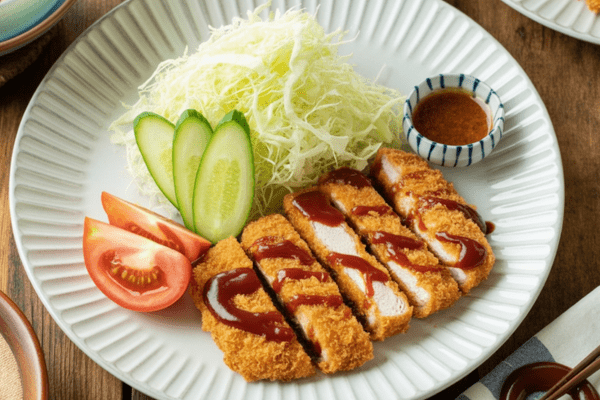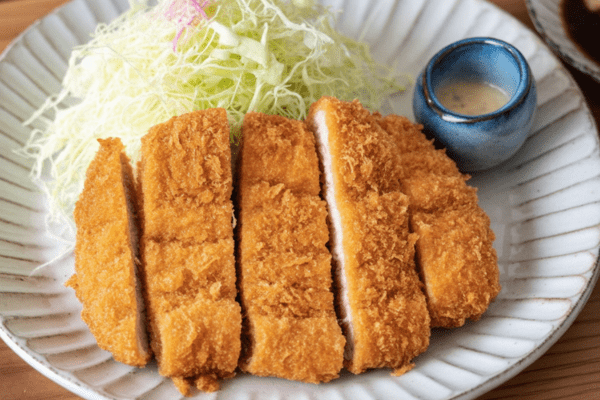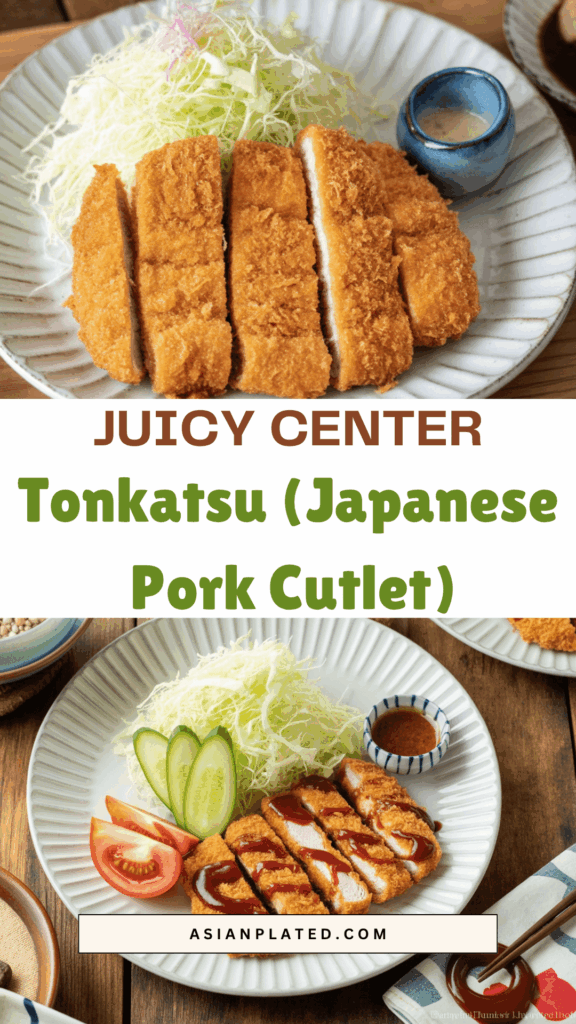If you’ve never tried making Tonkatsu at home, let me tell you—it’s way easier than you might think. This golden, crispy pork cutlet with a juicy center is one of those dishes my family requests on repeat. It’s real comfort food, the kind that makes you look forward to dinner all day.

I love serving it with a big pile of finely shredded cabbage and a tangy sesame dipping sauce. And while it sounds fancy, the prep is super straightforward once you get into the swing of it.
What is Tonkatsu?
Tonkatsu is a classic Japanese dish of breaded, deep-fried pork cutlets. It literally means “pork cutlet” in Japanese, with ton for pork and katsu for cutlet.
It originally started as a Western-inspired dish in the late 1800s, when Japan began adapting European recipes to local tastes. Over time, it became a staple of Japanese home cooking and restaurant menus alike.
For me, Tonkatsu is that go-to meal when I want something both crispy and deeply satisfying. It’s the sort of dish you might see on a casual lunch set in Japan, served with rice, soup, pickles, and that signature mountain of crisp cabbage.

Why I Love This Recipe
What really wins me over about homemade Tonkatsu is how light and crisp the breading turns out. I always use panko breadcrumbs because they’re so flaky and give you that airy crunch you can’t get from regular breadcrumbs.
It’s also really versatile. Most of the time I serve it with shredded cabbage and a drizzle of sauce. But sometimes, especially on a colder night, I’ll simmer the cutlet with onions and egg over rice for katsudon—comfort in a bowl.
Despite sounding elaborate, it’s such a simple dish at heart. Just a few basic ingredients, and you’re rewarded with something that feels restaurant-worthy at your own table.
Ingredients for Tonkatsu
Here’s what I always grab when I’m making Tonkatsu:
- Pork loin or pork tenderloin: I like using pork loin because it has a good balance of meat and fat, making it juicy. Pork tenderloin is leaner but still works great.
- Salt and black pepper: Just enough to bring out the flavor of the pork.
- All-purpose flour: Helps the egg stick.
- Eggs: Acts as glue for the panko.
- Panko breadcrumbs: The star of the show. They make that crisp, airy crust.
- Neutral oil: I use vegetable or canola oil for frying.
- Tonkatsu sauce: That sweet-savory tang makes every bite.
- Sesame seeds (optional): I love grinding them into the sauce for extra depth.

Substitutions
If pork isn’t your thing, you can easily swap in chicken breast to make Chicken Katsu. It’s the same method, just a different protein.
As for the sauce, I usually make my own with Worcestershire, ketchup, oyster sauce, and sugar. It’s quick and you can tweak it to taste. Store-bought tonkatsu sauce is great too, but homemade feels special.
What’s Japanese Panko?
Panko is one of my pantry must-haves. These coarse, flaky Japanese breadcrumbs stay so much crunchier than regular breadcrumbs because they’re made from crustless bread.
If you want the real deal texture you get at Japanese restaurants, use a Japanese brand if you can find it. Sometimes, if I have time, I spray the dried panko lightly with water to mimic the fresh style you get in Japan. It gives it an even more delicate crunch.
How to Make Tonkatsu
Preparation
- Make the dipping sauce
I like to grind toasted sesame seeds with a mortar and pestle before mixing them with tonkatsu sauce. It gives it this incredible nutty depth. Pour it into small bowls so everyone can dip at the table. - Prepare the pork
I trim any big bits of fat and then make small slits around the edge to keep it from curling when it fries. Then I give it a good pounding with a meat mallet. Not only does it tenderize the meat, but it makes for even cooking. A bit of salt and pepper and you’re set. - Set up the breading station
I always lay out three shallow dishes: flour in the first, beaten eggs in the second, and panko in the third. It keeps the mess contained and makes assembly quick. Meanwhile, I heat oil in a deep pot to about 340°F (170°C). A kitchen thermometer really helps here—you want the oil hot enough to crisp the breading without burning it. - Bread the pork
I dredge each cutlet in flour first, tapping off the excess. Then a quick dip in the egg, making sure it’s fully coated, and finally a generous press into the panko. I really make sure the panko sticks for that good crust.
Cooking
- First Fry
I fry each cutlet for about a minute on one side, then flip for another minute. It’s important not to crowd the pot—I usually do one or two at a time so the temperature stays steady. After this first fry, I transfer them to a wire rack. - Second Fry
Then I raise the oil to 355°F (180°C) for the second fry. This is the trick for that extra crisp finish. Another 30 seconds or so on each side does it. I always skim stray breadcrumbs from the oil between batches to keep it clean.
Assemble
- Cut and Serve
I let the cutlets rest briefly before slicing them into thick, juicy pieces. They stay so crispy this way. I usually serve them over a bed of shredded cabbage, with rice on the side. The dipping sauce goes in small bowls so everyone can dunk as much as they want.
Recipe Tips
- Shake off excess flour before dipping in egg. It helps the coating stay on without clumping.
- Keep an eye on the oil temperature. A thermometer is your best friend here.
- Don’t crowd the pot. Too many cutlets lower the oil temp and make them greasy.
- Double-fry for max crunch. The resting time between fries helps set the crust.
- Clean your oil with a skimmer so burnt crumbs don’t ruin the next batch.
Variations and Customizations
- Add some garlic, onion, or ginger powder to the flour for extra flavor.
- If you want to skip frying, you can bake it. It’s cleaner and still really good.
- Don’t worry about sesame seeds if you don’t have them. Plain tonkatsu sauce is delicious on its own.
What to Serve with Tonkatsu
I always go for shredded cabbage on the side. It’s crisp, refreshing, and balances the richness perfectly.
If I have time, I’ll throw together a simple cucumber salad or quick-pickled veggies for crunch. For a cozy meal, I love serving it with miso soup or tonjiru (a heartier pork and veggie miso soup). And of course, don’t forget the rice—it soaks up all the sauce and makes every bite better.
Storage and Reheating Tips
Once cooled, I store leftovers in an airtight container in the fridge for a few days. For longer storage, I freeze them.
When reheating, the oven is your best bet. It keeps the crust crispy—350°F (180°C) for about 15–20 minutes if thawed, or 30–40 minutes straight from the freezer.
Tonkatsu (Japanese Pork Cutlet)

There’s something undeniably comforting about a plate of golden, crispy tonkatsu—especially when paired with a cool cabbage salad and a savory-sweet sesame dipping sauce. This dish has been a beloved favorite at our dinner table for years, and once you’ve tasted that airy, shatteringly crisp crust and juicy pork inside, you’ll understand why.
Today, I’m walking you through everything you need to make perfect tonkatsu at home—from creating the ideal breading to mastering the double-fry technique. It’s easier than you think and so satisfying when done right.
Ingredients
For the Shredded Cabbage Salad (Optional but classic!)
- ¼ head of green cabbage, finely shredded
- 1 Japanese or Persian cucumber, thinly sliced into matchsticks
- 4 Tbsp Japanese sesame dressing (store-bought or homemade)
For the Sesame Dipping Sauce
- 1 Tbsp toasted white sesame seeds
- 1 Tbsp toasted black sesame seeds
- 4 Tbsp tonkatsu sauce (store-bought or homemade)
For the Breading
- ½ cup Japanese panko breadcrumbs (fresh if possible)
- 1 large egg
- ½ Tbsp neutral oil (like canola or vegetable)
- 2 Tbsp all-purpose flour
For the Pork Cutlets
- 2 boneless pork loin chops (about ½ inch thick)
- ½ tsp kosher salt
- ⅛ tsp freshly ground black pepper
- 3 cups neutral oil (for deep frying)
Instructions
<ol><p>Step 1: Prep the Cabbage Salad</p><p>Crisp, cool cabbage is the traditional pairing with tonkatsu and a beautiful contrast to the warm, rich pork cutlet. Use a sharp knife or cabbage slicer to get ultra-thin ribbons of cabbage. Slice the cucumber diagonally and cut into strips. Toss together and chill with sesame dressing until ready to serve.</p><p>Step 2: Mix Up the Dipping Sauce</p><p>Using a mortar and pestle, grind the sesame seeds just enough to release their aroma—leave a few whole for texture. Divide them into small sauce bowls and pour the tonkatsu sauce over each. This adds a nutty depth that’s absolutely irresistible.</p><p>Step 3: Prepare the Panko</p><p>If you’re using dried panko, soften it up by misting with a little water and letting it sit for 15 minutes. Fresh panko gives you that signature light crunch, so if you can find it—or make it from Japanese milk bread—it’s worth the effort.</p><p>Step 4: Ready Your Breading Station</p><p>Whisk together the egg and neutral oil in a shallow dish. Set up another dish with flour, and your moistened panko in a third. The oil in the egg helps the breading cling better and prevents it from separating when frying.</p><p>Step 5: Prep the Pork</p><p>Trim off any excess fat from the pork chops. Then, make several small cuts along the connective tissue on both sides—this keeps the meat from curling while frying. Gently pound both sides with a meat mallet and reshape with your hands. Season with salt and pepper.</p><p>Step 6: Bread the Pork</p><p>Dredge each piece in flour (shake off the excess), then dip in the egg mixture, and finally coat with panko. Press gently so the crumbs stick well. Let them rest for 5–10 minutes—this helps the coating stay put during frying.</p><p>Step 7: First Fry</p><p>Heat your oil to 340°F (170°C). Carefully lower one cutlet into the oil and let it fry undisturbed for a minute. Flip and cook the other side for another minute. Remove and let the cutlet rest on a wire rack for 4 minutes. This rest allows the pork to finish cooking gently from residual heat.</p><p>Repeat with the second cutlet, cleaning out any stray crumbs between batches to keep the oil fresh.</p><p>Step 8: Second Fry</p><p>Raise the oil temperature to 355°F (180°C). Give each cutlet a final 30-second fry on each side to crisp up the coating. Drain well on a rack to keep it crunchy.</p></ol>
Nutrition Information:
Yield: 2 Serving Size: 1Amount Per Serving: Calories: 3670Total Fat: 373gSaturated Fat: 29gTrans Fat: 3gUnsaturated Fat: 326gCholesterol: 189mgSodium: 1279mgCarbohydrates: 52gFiber: 8gSugar: 14gProtein: 41g
Asianplated.com, occasionally offers nutritional information for recipes contained on this site. This information is provided as a courtesy and is an estimate only. This information comes from online calculators. Although allchickenrecipes.com attempts to provide accurate nutritional information, these figures are only estimates.
Frequently Asked Questions
Can I use chicken instead?
Absolutely. Just swap in chicken breast and follow the same method.
Can I bake instead of fry?
Yes! I often do a baked version when I want less mess.
Where can I buy panko?
Most supermarkets carry it these days, but I look for Japanese brands for the best texture.
What oil should I use?
Any neutral oil works—I usually go with vegetable or canola.
Tonkatsu might seem like a restaurant treat, but once you try it at home, you’ll see how easy—and rewarding—it is to make. It’s one of those meals that brings everyone to the table with big smiles, and that’s why it’s one of my favorites.
Try other recipes:

